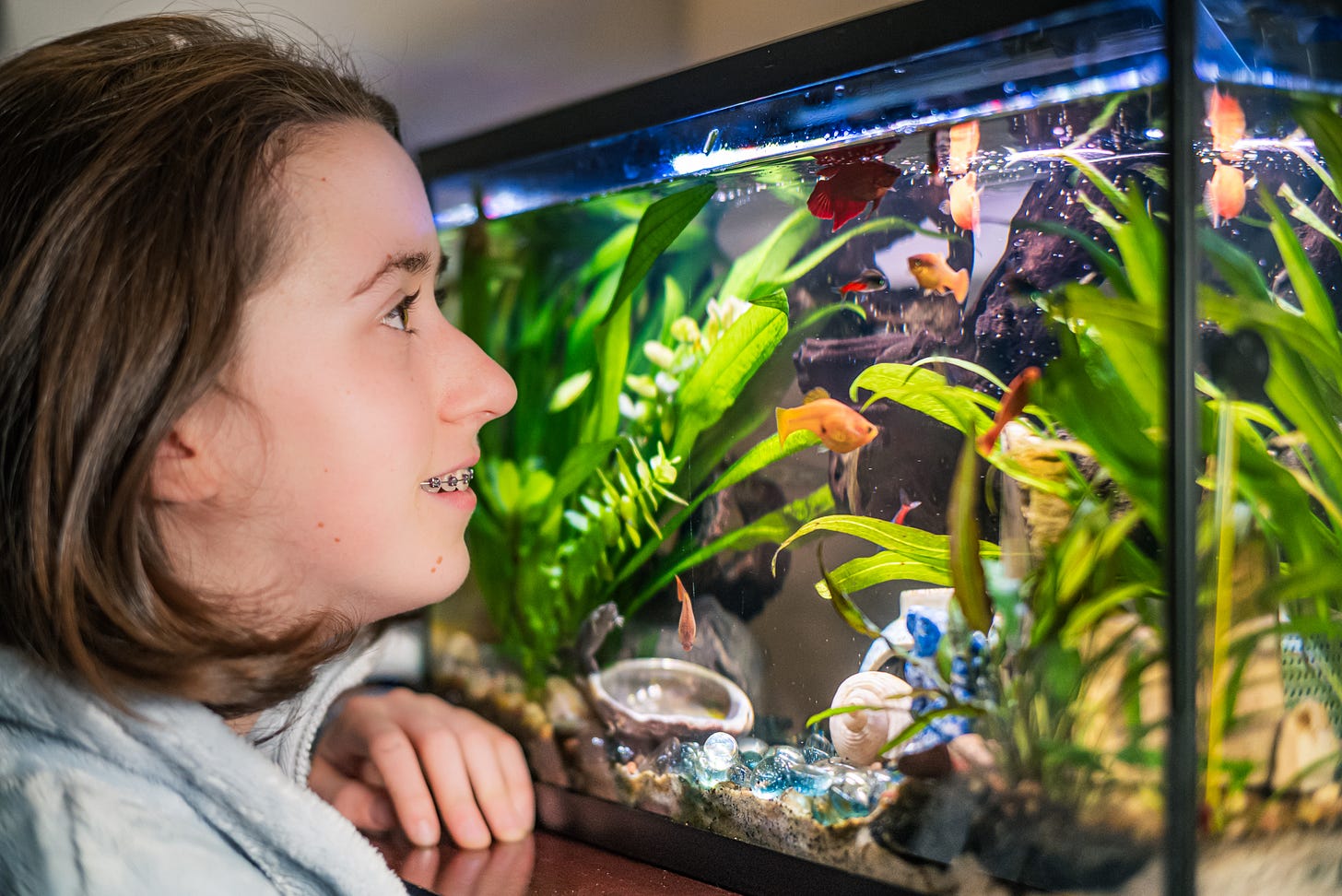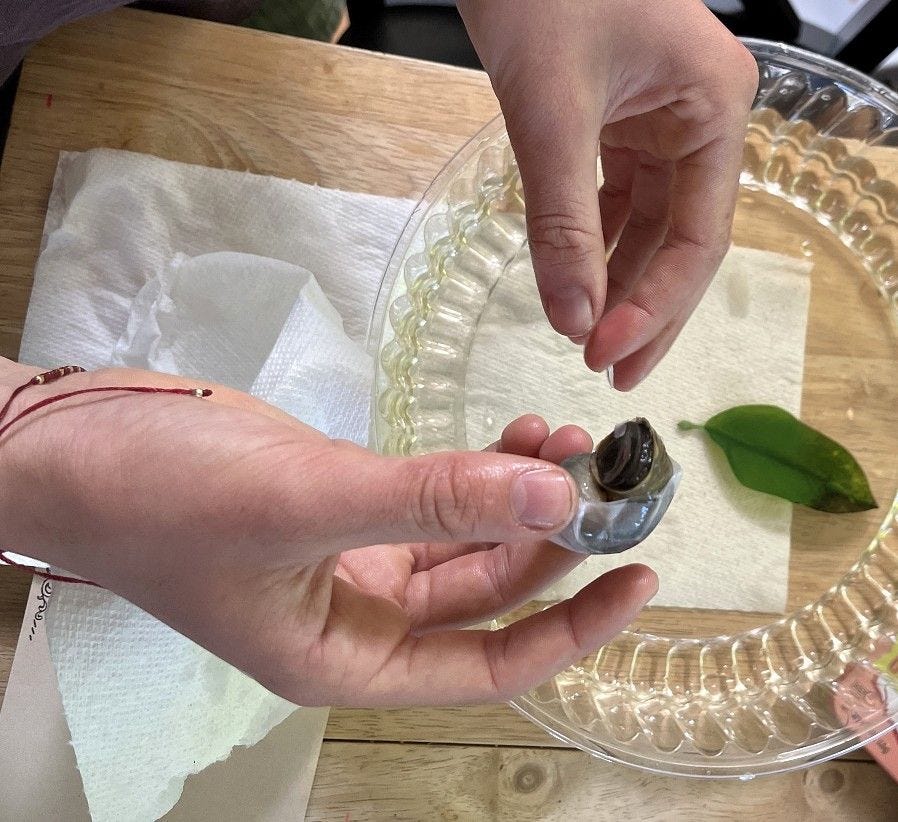Designing Little Underwater Worlds
Sure, you could just pop a few pebbles and a goldfish in a bowl, and call it a day—but for a budding young aquarist, creating a healthy, diverse underwater ecosystem is much more interesting.

Hello Craftsmanship readers,
This is
, Contributing Editor and longtime freelance writer for this magazine. For last week’s featured story, “Raising Corals in the New Age of Aquaria,” I interviewed Ed Deane, owner of Clear Water Aquarium and an expert in the tricky, pricey, and fascinating business of successfully growing corals in captivity.As I was researching the story, I learned much more about the craft of aquaria that I would have loved to include—such as this “sidebar” interview with a young freshwater aquarist. I hope you’ll enjoy it!

Designing Little Underwater Worlds
by
When Periwinkle—one of Noa Wonderly’s mystery snails—cracked its shell, the 13-year-old aquarist hit the books. After hours of research, she learned that some snail shells can be repaired using, as a dressing, the inner membrane of an eggshell. Though Periwinkle lived only a few more days after Noa’s bandaging, the incident illustrates her precocious fascination—and skill—with aquaria and their creatures.
A lifelong animal lover who volunteers weekly at Sonoma County Wildlife Rescue, Noa is a willowy teen with a cool, direct gaze. And though she’s a relative newcomer to freshwater aquaria, she’s leaped right into the deep end. I ask what got her interested.
“A couple of my friends had fish tanks, so I asked for one last Christmas. But the first three months I didn't really have many animals. I was mostly setting up, and putting in plants.”
At present, Noa has 11 fish, “which is technically one more than I should. But since I have plants and a good filter, it provides enough oxygen for all of the fish to be happy.”
Her species include five orange platies—two big and three small—five neon tetras, and a female betta fish. “The tetras are super sturdy. And the three little platies are from thirteen babies that I raised. I gave the other ten away,” she says. “That would be way too many fish.” She also has three small Otocinclus catfish (which Noa doesn’t count, because they help clean the tank).
“What do you love about this?” I ask.
“I really like designing habitats, and making little worlds. This is just another habitat for me to work on.”
And it’s an impressive one. With only a 10-gallon tank—and a total investment of around $300—Noa has choreographed a marvelous interplay of species. These include her fish and catfish, three bright red cherry shrimp, which I can’t find (“They like to hide out in the Amazon fern”), two striped Nerite snails, and two yellow mystery snails. There’s also a fully aquatic African dwarf frog, which darts through the plants like a tiny amphibious gymnast.

Maintaining even a small freshwater aquarium isn’t child’s play. It entails—among other things—a weekly cleaning regimen to “keep all of the different animals happy.” Noa let me witness some of the many-stepped process.
“The main part,” Noa explains, “is a water change. I use a siphon to pull up the water, then I skim the sand to pick up all the fish poop and debris. I give some of my objects [i.e., a blue ceramic bowl, a couple of big rocks, some pieces of mopani wood] a vinegar soak to get the algae off. I clean the glass, and usually clean out the filter. I also rearrange in there a little bit, and move the logs around. Then I refill, and put the fish back in.”
And that’s for a relatively manageable 10-gallon tank. Does she see herself getting a larger aquarium at some point?
“I don't know.” She shrugs. “I kind of like the size of this one. It's just enough stuff to keep me busy, but not super hard to maintain.”
The most surprising thing Noa has discovered?
“How much personality the fish have. The small ones not so much. But the female platy is bossy—she’ll chase the other fish—and the male is kind of skittish. My frog or even my snails definitely have personalities—and they're all different from each other.”
ICYMI…
Read: ”Raising Corals in the New Age of Aquaria,” written by .
In the U.S. alone, nearly 3 million homes have a saltwater aquarium. And globally, the market is worth billions of dollars. Could this booming hobby become a force for ocean conservation?
Coming soon…
On our next episode of The Secrets of Mastery, we’ll interview
—an outdoorsman, cookbook author, and James Beard Award-winning chef who focuses on wild foods.“The Secrets of Mastery” is a series of intimate conversations with artisans, innovators, and other pioneers about what it takes to master their craft, and why handmade matters. It’s available only for paid subscribers here on Substack, so if you haven’t done so already, you can upgrade your subscription now for just $6/month, or $60/year.
Craftsmanship Magazine is a not-for-profit, multimedia publication that focuses on master artisans and innovators whose work informs our quest: to create a world built to last. In addition to our paid offerings, you’ll find a rich archive of in-depth reported features, audio stories, photo essays, Field Notes, and documentary shorts on our free website—along with community resources like our Artisans’ Directory, our guide to U.S.-based craft & folk schools, and much more.





